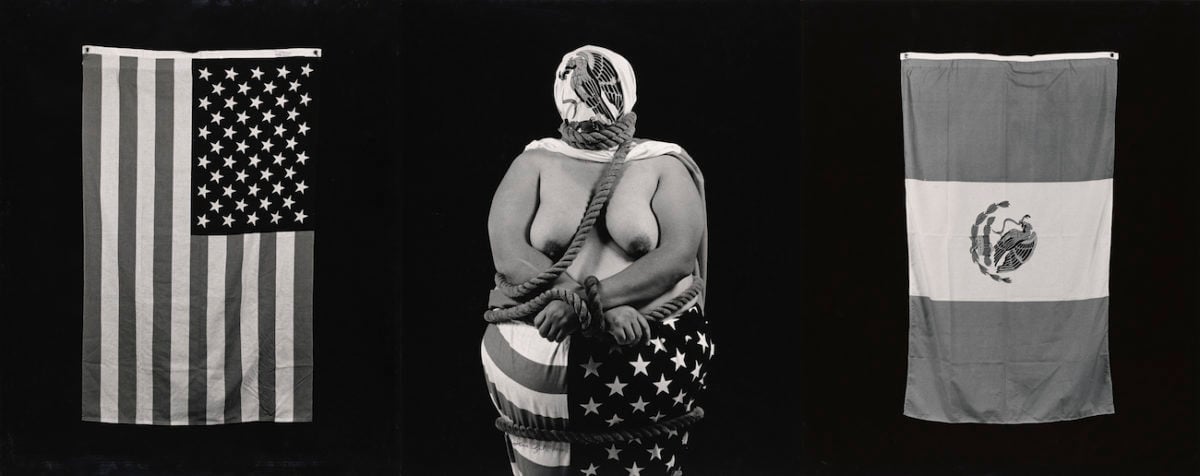
Laura Aguilar is well known for her iconic triptych “Three Eagles Flying.” Featuring her signature self-portraiture, the artist’s nude body takes on a form of rebellion against the colonization of Latinx identities – racial, gender, cultural, and sexual. Photo: The J. Paul Getty Museum, Los Angeles. Purchased with funds provided by the Photographs Council. © Laura Aguilar Trust of 2016.
Photographer Laura Aguilar created work that explored her own identity, challenged traditional notions of beauty, and celebrated the ties that bound her to the Latinx, lesbian, and working-class communities in East Los Angeles.
Aguilar died last year at the age of 58, but some of her most important photographs will live forever thanks to a recent purchase by the J. Paul Getty Museum.
Laura Aguilar photos
The acquisition, which happened in September, includes 35 photographs from five series that span Aguilar’s 30-year career.
Some of the photos includes prints from “Plush Pony,” a 1992 series that features portraits taken at the defunct East Los Angeles lesbian bar of the same name. These photos are intimate, tender, and joyful.
Plush Pony
While these women frequently faced discrimination and physical danger outside the bar, these photos celebrate lesbians who are enjoying a sense of comfort in their safe space.
“The work of Laura Aguilar is incredibly important and helps us better understand the role photography has played in the diverse communities of Southern California,” Jim Ganz, senior curator in the Getty Museum’s Department of Photographs, said in a statement.
Some of Aguilar’s photos will be featured in the exhibition “Unseen: 35 Years of Collecting Photographs,” which opens December 17 at The Getty Center.
Early years
Aguilar grew up in the San Gabriel Valley and started photography in high school. She continued studying the medium in the early 1980s while attending East Los Angeles College, where she also became more attuned to her Mexican-American identity through courses in Chicano studies.

Laura Aguilar’s series “Plush Pony” features portraits taken at the defunct East Los Angeles lesbian bar of the same name. These photos are intimate, tender, and joyful. This photo is “Plush Pony #6.” Photo: Photo: The J. Paul Getty Museum, Los Angeles. Purchased with funds provided by the Photographs Council. © Laura Aguilar Trust of 2016.
Intersectionality
In the mid-1980s, while coming to terms with her sexuality (Aguilar identified as a lesbian), Aguilar became actively engaged with LGBTQ causes. As a result, themes related to race, sexuality, marginalization, and economic disparity became defining characteristics of her work.
In 2017, the Vincent Price Art Museum at East Los Angeles College presented “Laura Aguilar: Show and Tell,” the artist’s first comprehensive retrospective. The exhibit was a highlight of the Getty’s “Pacific Standard Time: LA/LA project,” a region-wide initiative that explored Latin American and Latinx art in dialogue with Los Angeles. Aguilar passed away shortly after the exhibition closed.
‘Latina Lesbian’
The Getty acquisition also includes several other recognizable Aguilar photographs.
The “Latina Lesbian” portrait series showcases lesbians from various social and economic backgrounds and includes first-person narratives about their identities. The photos were taken between 1986 and 1990.
Also included is one of Aguilar’s most recognizable works, “Three Eagles Flying.” In this 1990 triptych, Aguilar wraps her body in the national flags of Mexico and the United States to highlight the intersectionality of cultural identity and politics.
In front of the camera
Aguilar also performed for the camera throughout her career. After meeting photographer Judy Dater, whose work explored the relationship between the figure and the landscape, Aguilar became interested in the same topic.
For example, in the 1996 photograph “Nature Self-Portrait,” Aguilar’s nude body mimics the rock formations and fallen tree trunks that populate the largely arid terrain of the desert.
In 1999’s “Motion,” Aguilar photographed groups of nude women, herself included, in poses that juxtapose the vulnerability of the human flesh with the rough and uneven surfaces of the landscape.
